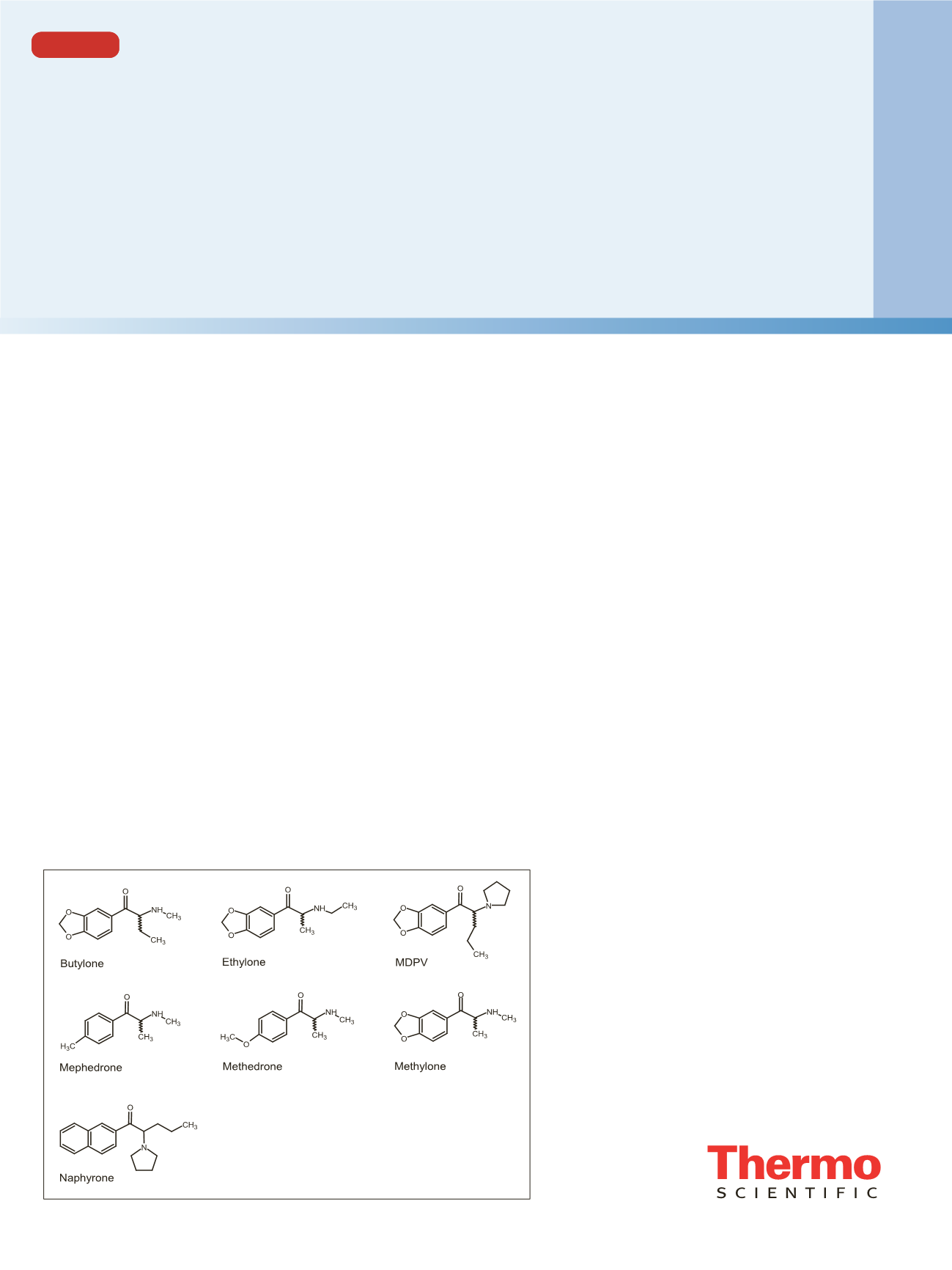

Quantitation of Bath Salts/Cathinones in
Urine by LC-MS/MS
Kristine Van Natta, Marta Kozak, Thermo Fisher Scientific, San Jose, CA
Application Note 596
Key Words
Cathinone, bath salts, designer drugs, MDPV, methylone, mephedrone,
ethylone, butylone, naphyrone, methedrone, TSQ Quantum Ultra,
liquid/liquid extraction, forensic toxicology
Goal
To develop an LC-MS/MS method for the analysis of the three Schedule I
cathinones (MDPV, methylone and mephedrone), as well as other
substituted cathinones (methedrone, ethylone, butylone and naphyrone)
in urine with LOQs of 1 ng/mL for forensic toxicology.
Introduction
Substituted cathinones, sometimes know as “bath salts,”
have become the latest abused designer drugs. Based on
cathinone, a substance found in the African
Catha edulis
(khat) plant, substituted cathinones are stimulants with
amphetamine- and cocaine-like effects. As with many
designer drug classes, variations on base structure abound
(Figure 1). On October 21, 2011 the United States Drug
Enforcement Agency (US DEA) listed three of the most
common substituted cathinones: methylenedioxy-
pyrovalerone (MDPV), methylone, and mephedrone, as
Schedule I drugs, thereby making them illegal. As these
drugs are not detected by current ELISA drug screening
tests, new methods are needed to detect and quantify them.
Experimental
Sample Preparation
Deuterated internal standards were available for all
compounds except methedrone and naphyrone. Butylone-
d
3
was used as internal standard for methedrone and MDPV-
d
8
was used for naphyrone.
Sample preparation was a liquid-liquid extraction (LLE).
First, 200 μL of urine and 10 μL of internal standard mix
solution (2 μg/mL of each deuterated IS) were basified
with 100 μL of 1 N NaOH. Extraction was performed by
adding 1 mL of ethylacetate/hexane (1:1), mixing, and
centrifuging. Then, an 800 μL aliquot of the resulting
supernatant was transferred to a clean test tube containing
20 μL of DMSO to prevent complete evaporation of
solvent. Analytes have low molecular weight, are slightly
volatile, and will evaporate if left too long in the
evaporator. The supernatant was evaporated at 37 °C
under nitrogen for 15 minutes. Samples were diluted with
200 μL of 5% methanol and transferred to an HPLC vial
equipped with a limited-volume insert. Finally, 20 μL was
injected into the LC-MS system.
Liquid Chromatography
Chromatographic separations were performed under
gradient conditions using a Thermo Scientific
™
Accela
™
1250 pump and Accela Open autosampler. The analytical
column was a Thermo Scientific
™
Hypersil GOLD
™
column (50 x 2.1 mm,1.9 μm particle size). The column
was maintained at room temperature. The injection
volume was 20 μL. Mobile phases A and B consisted of
10 mM ammonium formate with 0.1% formic acid in
water and methanol, respectively. Mobile phase C was
acetonitrile/1-propanol/acetone (45:45:10). All mobile
phases were Fisher Chemical
™
brand solvents. A shallow
gradient at a flow rate of 500 µL/min was used to separate
isomeric ethylone and butylone. The total run time was
5 minutes.
Figure 1. Structures of substituted cathinones (bath salts)



















